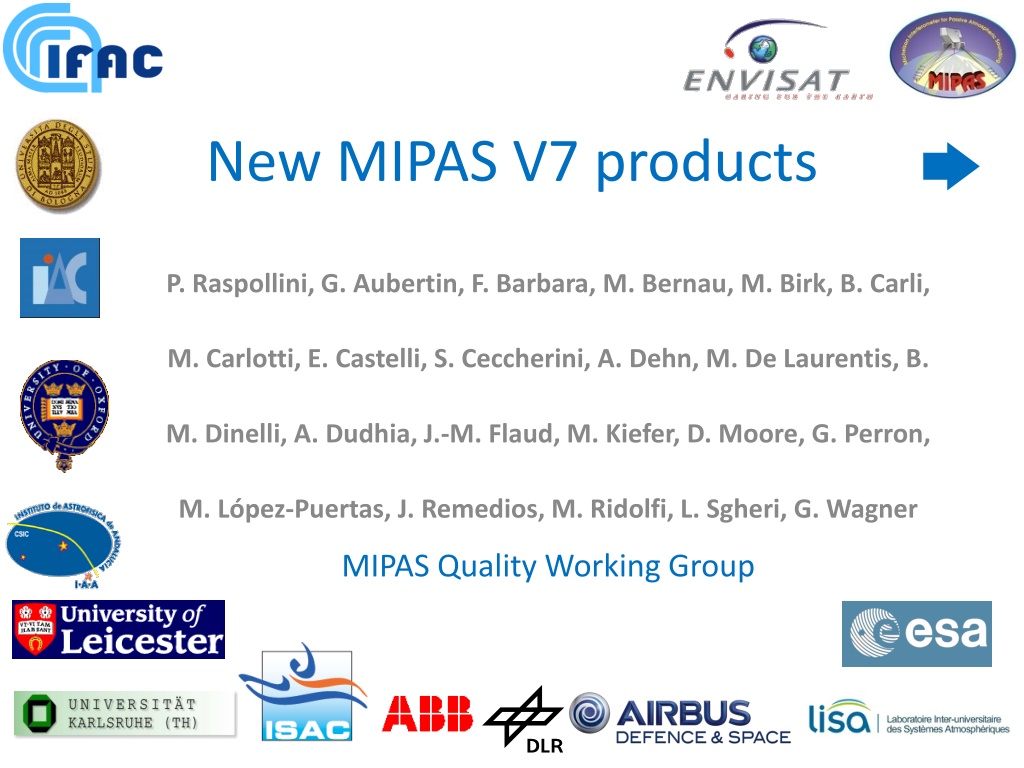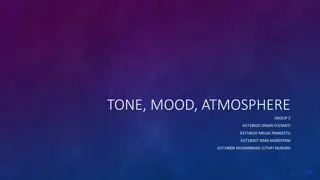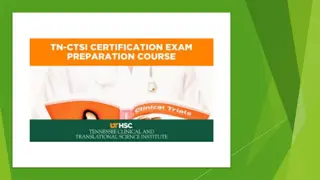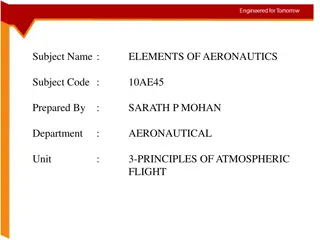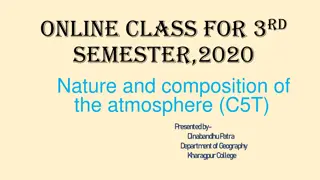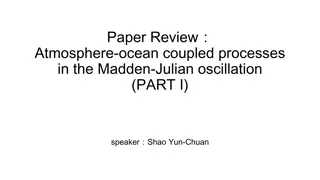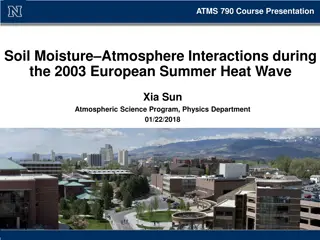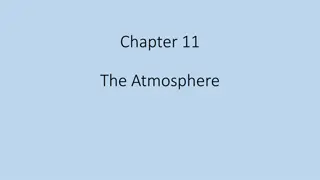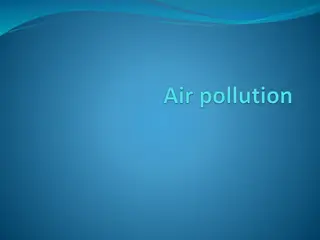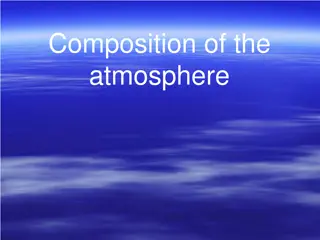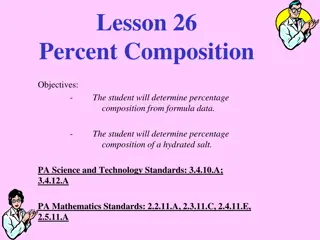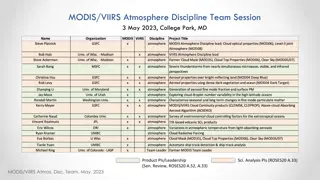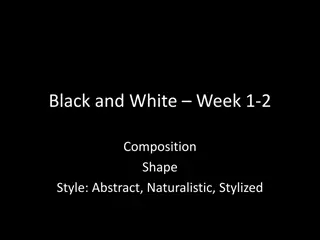Understanding Atmosphere Composition Trends with New MIPAS V7 Products
New MIPAS V7 products, based on data from the MIPAS instrument onboard the ENVISAT satellite from 2002 to 2012, offer improved measurements of atmospheric composition. The reprocessing efforts with the updated ML2PP V7 processor have corrected instrumental drifts, allowing for accurate trend analysis of Ozone-Depleting Substances (ODS) like HCFC-22, CCl4, and CFCs. The annual trends of these substances as a function of latitude and altitude provide valuable insights into atmospheric changes. Explore the detailed information provided by the MIPAS Quality Working Group at the EGU General Assembly 2015.
Download Presentation

Please find below an Image/Link to download the presentation.
The content on the website is provided AS IS for your information and personal use only. It may not be sold, licensed, or shared on other websites without obtaining consent from the author. Download presentation by click this link. If you encounter any issues during the download, it is possible that the publisher has removed the file from their server.
E N D
Presentation Transcript
New MIPAS V7 products P. Raspollini, G. Aubertin, F. Barbara, M. Bernau, M. Birk, B. Carli, M. Carlotti, E. Castelli, S. Ceccherini, A. Dehn, M. De Laurentis, B. M. Dinelli, A. Dudhia, J.-M. Flaud, M. Kiefer, D. Moore, G. Perron, M. L pez-Puertas, J. Remedios, M. Ridolfi, L. Sgheri, G. Wagner MIPAS Quality Working Group New MIPAS V7 products EGU General Assembly 2015, Vienna, 12-17 April 2015 Page 1
New MIPAS V7 products MIPAS onboard ENVISAT satellite performed almost continuously measurements of the three dimensional atmospheric composition from 2002 to 2012. The MIPAS ESA processor (current release ML2PP V6) was specifically designed for near real time operational analysis ( => automatic operations in different atmospheric conditions) and without biases in the retrieved profiles (=> minimal use of external constraints). A new full mission reprocessing , which includes significant improvements in both L1 and L2 processor, is in progress (a Diagnostic dataset is now available, the full release, named ML2PP V7, will be available in May 2015). In particular, a drift in the instrumental gain was corrected and trends of observed species can be measured with improved accuracy. With the new data we have started the determination of the latitude and altitude dependent trends of some Ozone-Depleting Substances (ODS) included in the Montreal Protocol. Preliminary results confirm the positive trend of HCFC-22 and the negative trend of CCl4and CFCs concentrations in troposphere. New MIPAS V7 products EGU General Assembly 2015, Vienna, 12-17 April 2015 Page 2
New MIPAS V7 products Annual trends as a function of latitude and altitude CFC-12 CFC-11 CCl4 HCFC-22 New MIPAS V7 products EGU General Assembly 2015, Vienna, 12-17 April 2015 Page 3
New MIPAS V7 products P. Raspollini, G. Aubertin, F. Barbara, M. Bernau, B. Carli, M. Carlotti, E. Castelli, S. Ceccherini, A. Dehn, M. De Laurentis, B. M. Dinelli, A. Dudhia8, J.-M. Flaud, M. Kiefer, D. Moore, G. Perron, M. L pez-Puertas, J. Remedios, M. Ridolfi, L. Sgheri MIPAS Quality Working Group By clicking on the different rectangles of this slide it is possible to obtain more information on each particular subject. MIPAS on ENVISAT 2002-2012 MIPAS on ENVISAT 2002-2012 ESA processor V6 (current release) ESA processor V6 (current release) Improvements in L1 Improvements in L1 Validation ESA processor V7 (next release May 2015) ESA processor V7 (next release May 2015) Validation Improvements in L2 Improvements in L2 Trends of ODSs Trends of ODSs HCFC-22 CCl4 CFC-11 CFC-12 HCFC-22 CCl4 CFC-11 CFC-12 New MIPAS V7 products EGU General Assembly 2015, Vienna, 12-17 April 2015 Page 4
MIPAS on ENVISAT (2002-2012) From April 2002 to April 2012 MIPAS (Michelson Interferometer for Passive Atmospheric Sounding) measured almost continuously the atmospheric emission in the middle infrared (685- 2410 cm-1) at limb. Fischer et al., 2008 685 cm-1 14.6 m 2410 cm-1 4.15 m Spectrum at 28 km tangent altitude New MIPAS V7 products EGU General Assembly 2015, Vienna, 12-17 April 2015 Page 5
MIPAS on ENVISAT (2002-2012) NO2 VMR at 37 km Continuous, altitude resolved measurements, both during day and night, allow the determination of the diurnal variability of the compounds and of the temporal and latitudinal variation of their vertical distribution. Time-series of Ozone profile in the latitude band 65S-90S Time-series of latitude dependence of Ozone at 21 km X X New MIPAS V7 products EGU General Assembly 2015, Vienna, 12-17 April 2015 Page 6
ESA processor V6 (current release) (1/3) MAIN FEATURES OF THE RETRIEVAL APPROACH The MIPAS ESA processor (current release ML2PP V6, see Raspollini et al., 2006) was specifically designed for near real time operational analysis (and hence capable of operating in an automatic way in different atmospheric conditions) and for having minimal biases in the retrieved profiles (making minimal use of external constraints). Further than the near real time analysis, whose requirement was the distribution of the products within three hours from the measurement time, the same processor was also used for the offline analysis, performed on consolidated Level 1 data. Main features of the retrieval algorithm: Retrieval at the pressure grid identified by the tangent points of the limb scan sequence. Sequential retrieval of the target species: first simultaneous retrieval of the pressure corresponding to the measured tangent points and related temperature values , then retrieval of VMR of H2O, O3, HNO3, CH4, N2O, NO2, CFC-11, CFC-12, ClONO2, N2O5. Global fit analysis, i.e. simultaneous inversion of the measurements relating to a whole limb-scan sequence. Use of masks and microwindows , i.e. of selected spectral elements in selected spectral intervals containing relevant information on target parameters and less affected by systematic errors (non-LTE and horizontal inhomogeneities). Cloud filtering of spectra. Non-linear least squares fit using the Gauss-Newton method modified with the regularizing Levenberg-Marquardt technique. A posteriori regularization with a self-adapting strength X X New MIPAS V7 products EGU General Assembly 2015, Vienna, 12-17 April 2015 Page 7
ESA processor V6 (current release) (2/3) HANDLING OF ILL-CONDITIONING OF THE RETRIEVAL PROBLEM The regularizing Levenberg-Marquardt technique within the iterations and a posteriori regularization with a self-adapting strengtht dependent on the random error of each profile are applied to constraint possible ill- conditioning of the retrieval problem. The consequence of the use of a self-adapting regularization scheme in the retrieval algorithm is that random errors, (as well as systematic errors ), are dependent on the latitude and season. On the contrary, a small variation of the vertical resolution is obtained for different atmospheric conditions. An example for Ozone is shown. Ozone absolute noise error profile (left plot) and vertical resolution profile (right plot) averaged on all profiles of the 65 S-90 S latitude band in the four seasons of year 2008 (December 2007, January and February 2008 (DJF), March, April and May 2008 (MAM), June, July and August 2008 (JJA), September, October and November 2008 (SON)). X X New MIPAS V7 products EGU General Assembly 2015, Vienna, 12-17 April 2015 Page 8
ESA processor V6 (current release) (3/3) X October 2007 monthly averages of some of the species retrieved by ML2PP V6 X H2O Temperature O3 HNO3 CH4 ClONO2 CFC-11 CFC-12 N2O Selected spectral intervals (microwindows) are used for each species and the different species are retrieved in sequence. New MIPAS V7 products EGU General Assembly 2015, Vienna, 12-17 April 2015 Page 9
ESA processor V7 (next release May 2015) ML2PP V7 will be a new offline analysis of the full mission. So far only a diagnostic dataset (about 4000 orbits) is available. The full mission reprocessing will be available at the end of May 2015. It contains significant improvements in both L1 processor, which provides geolocated and calibrated spectra, and L2 processor, which provides vertical VMR profiles of observed species. Examples of validation of ML2PP V7 products with correlative measurements are provided. X X New MIPAS V7 products EGU General Assembly 2015, Vienna, 12-17 April 2015 Page 10
Improvements in V7 L1 processor: correction of time dependent calibration error (1/2) In some studies of trends performed with MIPAS ML2PP V6 measurements (Ceccherini et al., 2011) the uncertainties caused by the drift of the instrument gain was identified as the largest source of error. Indeed, MIPAS detectors of some spectral bands are affected by nonlinearities that change with time due to the aging of the instrument. For L1 files used by V6 and previous versions the detector response as a function of the incident photon flux were characterized and parameterized before the ENVISAT launch and the characterization were used to perform the nonlinearity correction. In-flight measurements have now allowed nonlinearity correction in L1 V7 (used by ML2PP V7) (Birk and Wagner, 2013). Ratio between mean L1 V7 and L1 V5 radiance for one band affected by non- linearities. The effect of the correction is a reduction of the radiance at the beginning of the mission and then a progressive increase of the ratio up to 1.01 at the end of the mission. parameters of this Difference in the monthly mean of temperature profile retrieved when using L1 V7 files and L1 V5 files in July in the years 2002, 2008, 1010, 2011 X New MIPAS V7 products EGU General Assembly 2015, Vienna, 12-17 April 2015 X Page 11
Improvements in V7 L1 processor: correction of time dependent calibration error (2/2) The analysis of the differences between V7 and V6 profiles provides an indication of the error in V6 products due to unaccounted non-linearities. Temporal variation of V7 - V6 differences of temperature. Temporal variation of V7 - V6 differences of water vapor. Non-linearity correction impacts the species retrievals in two ways: a direct effect, due to changes in the radiance and an indirect effect, due to changes in temperature. X Improvements in L2 X New MIPAS V7 products EGU General Assembly 2015, Vienna, 12-17 April 2015 Page 12
Improvements in V7 L2 processor New continuum retrieval approach MW-dependent continuum profiles (including all the emission sources that are frequency independent within a microwindow) are fitted together with the unknown profile. While in V6, for each layer ith, the continuum cross-section kiwas retrieved, in V7 the transmission i=exp(-kiC) due to the continuum is retrieved. The sensitivity of the forward model to kivanishes for large enough values of kibecause of the exponential dependence, the new variables iare polynomially connected with the optical transparency of the layer due to the continuum, thus they are tightly linked to the measured spectra. The main effect of this improvement is that a better convergence towards the minimum of the 2is reached . Main effects of the new continuum approach The new approach generally leads to a significant reduction of the conditioning number of the matrix to be inverted. This, together with the reduced non-linearity of the forward model with respect to the new continuum variables, allows to decrease by a factor of 10 the initial value of the Levenberg- Marquardt parameter for the new retrieval variables. Results are that the final 2is reduced by about 3%, the number of iterations by about 15% and the number of degrees of freedom increased by 5% with respect to the previous approach. V6 V7 V6 V7 X X New MIPAS V7 products EGU General Assembly 2015, Vienna, 12-17 April 2015 Page 13
Improvements in V7 L2 processor Improved microwindows for the first phase of the mission (2002-2004) Upgraded microwindows for the analysis of the Full Resolution measurements are now used. The spectral intervals used by ML2PP V6 for the analysis of the Full Resolution measurements were selected with strong constraints for the computing time. A new selection was performed recently, the new microwindows being characterized by an improved information content. 80 80 OR OLD NEW 60 60 Altitude [km] Altitude [km] 40 40 20 20 OR OLD NEW 0 0,000 0 0,005 0,1 DOF/ z [km 0,2 0,3 -1] 0 1 2 10 10 10 -2] 0 2 4 6 0,2 DOF/ z [km 0,4 0,6 1 2 3 10 10 2 [km 10 2 [km NO2 VMR [ppmv] -2] -1] fi xi O3 VMR [ppmv] fi xi X (Ceccherini et al., 2013) X (Ceccherini et al., 2013) New MIPAS V7 products EGU General Assembly 2015, Vienna, 12-17 April 2015 Page 14
Improvements in V7 L2 processor: Retrieval of the following additional species:COF2, CCl4, CFC-14 , CFC-22 and HCN. HCFC-22 CCl4 COF2 CFC-14 X X Validation of V7 products New MIPAS V7 products EGU General Assembly 2015, Vienna, 12-17 April 2015 Page 15
Validation of V7 products MIPAS vs ACE-FTS HCFC-22 CFC-11 Differences smaller than 5% are obtained for HCFC-22 in the pressure range 400-20 hPa, for CFC-11 the difference is smaller than 5% only in the range 400-50 hPa, where the VMR is significantly different of 0. X X New MIPAS V7 products EGU General Assembly 2015, Vienna, 12-17 April 2015 Page 16
Validation of V7 products MIPAS V7 water vapor vs Frost Point Hygrometers (FPH) at different stations Courtesy of M. Kiefer - IMK A comparison between ML2PP V7 and ML2PP V6 H2O data with respect to FPH shows several improvements: Differences between FR and OR decreased V7 OR data are clearly smoother than V6 Bias of V7 vs. FPH is reduced compared to V6 X X New MIPAS V7 products EGU General Assembly 2015, Vienna, 12-17 April 2015 Page 17
Trends of Ozone-depleting substances (ODS) Methodology: Monthly means (green curve) have been calculated for each species at each altitude for latitude bins of 10 . The annual variability has been removed substracting from the monthly means the average for each month of the year for all observed years. The trend (red line) was obtained by linearly fitting the resulting values (blue curve). HCFC-22 CCl4 CFC-11 CFC-12 HCFC-22 CCl4 CFC-11 CFC-12 X X New MIPAS V7 products EGU General Assembly 2015, Vienna, 12-17 April 2015 Page 18
HCFC-22 Zonal means X CCl4 CFC-12 CFC-11 X CCl4 CFC-12 CFC-11 New MIPAS V7 products EGU General Assembly 2015, Vienna, 12-17 April 2015 Page 19
HCFC-22: trends vs latitude and altitude 40N-50N 40S-50S X CCl4 CFC-12 CFC-11 X CCl4 CFC-12 CFC-11 New MIPAS V7 products EGU General Assembly 2015, Vienna, 12-17 April 2015 Page 20
HCFC-22: trends vs latitude and altitude HCFC-22 trend (ppt/year) vs latitude at 3 pressure levels X CCl4 CFC-12 CFC-11 X CCl4 CFC-12 CFC-11 New MIPAS V7 products EGU General Assembly 2015, Vienna, 12-17 April 2015 Page 21
HCFC-22: trends vs latitude and altitude HCFC-22 trend (ppt/year) vs latitude and altitude HCFC-22 X CCl4 CFC-12 CFC-11 X CCl4 CFC-12 CFC-11 New MIPAS V7 products EGU General Assembly 2015, Vienna, 12-17 April 2015 Page 22
CCl4 Zonal means X HCFC-22 CFC-12 CFC-11 X HCFC-22 CFC-12 CFC-11 New MIPAS V7 products EGU General Assembly 2015, Vienna, 12-17 April 2015 Page 23
CCl4: trends vs latitude and altitude 40N-50N 40S-50S X HCFC-22 CFC-12 CFC-11 X HCFC-22 CFC-12 CFC-11 New MIPAS V7 products EGU General Assembly 2015, Vienna, 12-17 April 2015 Page 24
CCl4: trends vs latitude and altitude CCl4 trend (ppt/year) vs latitude at 3 pressure levels X HCFC-22 CFC-12 CFC-11 X HCFC-22 CFC-12 CFC-11 New MIPAS V7 products EGU General Assembly 2015, Vienna, 12-17 April 2015 Page 25
CCl4: trends vs latitude and altitude CCl4 trend (ppt/year) vs latitude and altitude CCl4 X HCFC-22 CFC-12 CFC-11 X HCFC-22 CFC-12 CFC-11 New MIPAS V7 products EGU General Assembly 2015, Vienna, 12-17 April 2015 Page 26
CFC-11 Zonal means X HCFC-22 CCl4 CFC-12 X HCFC-22 CCl4 CFC-12 New MIPAS V7 products EGU General Assembly 2015, Vienna, 12-17 April 2015 Page 27
CFC-11: trends vs latitude and altitude 40N-50N 40N-50N 40S-50S 40S-50S X HCFC-22 CCl4 CFC-12 X HCFC-22 CCl4 CFC-12 New MIPAS V7 products EGU General Assembly 2015, Vienna, 12-17 April 2015 Page 28
CFC-11: trends vs latitude and altitude CFC-11 trend (ppt/year) vs latitude at 3 pressure levels X HCFC-22 CCl4 CFC-12 X HCFC-22 CCl4 CFC-12 New MIPAS V7 products EGU General Assembly 2015, Vienna, 12-17 April 2015 Page 29
CFC-11: trends vs latitude and altitude CFC-11 trend (ppt/year) vs latitude and altitude CFC-11 X HCFC-22 CCl4 CFC-12 X HCFC-22 CCl4 CFC-12 New MIPAS V7 products EGU General Assembly 2015, Vienna, 12-17 April 2015 Page 30
CFC-12 Zonal means X HCFC-22 CCl4 CFC-11 X HCFC-22 CCl4 CFC-11 New MIPAS V7 products EGU General Assembly 2015, Vienna, 12-17 April 2015 Page 31
CFC-12: trends vs latitude and altitude 40N-50N 40S-50S X CCl4 HCFC-22 CFC-11 X CCl4 HCFC-22 CFC-11 New MIPAS V7 products EGU General Assembly 2015, Vienna, 12-17 April 2015 Page 32
CFC-12: trends vs latitude and altitude CFC-12 trend (ppt/year) vs latitude at 3 pressure levels X HCFC-22 CCl4 CFC-11 X HCFC-22 CCl4 CFC-11 New MIPAS V7 products EGU General Assembly 2015, Vienna, 12-17 April 2015 Page 33
CFC-12: trends vs latitude and altitude CFC-12 trend (ppt/year) vs latitude and altitude CFC-12 X HCFC-22 CCl4 CFC-11 X HCFC-22 CCl4 CFC-11 New MIPAS V7 products EGU General Assembly 2015, Vienna, 12-17 April 2015 Page 34
New MIPAS V7 products Percent annual trends as a function of latitude and altitude CFC-12 CFC-11 HCFC-22 CCl4 X New MIPAS V7 products EGU General Assembly 2015, Vienna, 12-17 April 2015 X Page 35
References Birk, M. and Wagner, G., Radiometric impact of new nonlinearity analysis , Technical Note, 12.11.2013 Ceccherini, S., Carli, B. , Raspollini, P. and Ridolfi, M., Rigorous determination of stratospheric water vapor trends from MIPAS observations, Optics Express, Vol. 19, Iss. S3, A340-A360 (2011) Ceccherini, S., Carli, B. and Raspollini, P., Quality of MIPAS operational products, Journal of Quantitative Spectroscopy and Radiative Transfer, Vol. 121, 45-55 (2013), doi: 10.1016/j.jqsrt.2013.01.021, 2013 Fischer, H., Birk, M., Blom, C., Carli, B., Carlotti, M., von Clarmann, T., Delbouille, L., Dudhia, A., Ehhalt, D., Endemann, M., Flaud, J. M., Gessner, R., Kleinert, A., Koopman, R., Langen, J., L pez-Puertas, M., Mosner, P., Nett, H., Oelhaf, H., Perron, G., Remedios, J., Ridolfi, M., Stiller, G., and Zander, R.: MIPAS: an instrument for atmospheric and climate research, Atmos. Chem. Phys., 8, 2151-2188, doi:10.5194/acp-8-2151-2008, 2008. Raspollini, P., Carli, B., Carlotti, M., Ceccherini, S., Dehn, A., Dinelli, B. M., Dudhia, A., Flaud, J.-M., L pez-Puertas, M., Niro, F., Remedios, J. J., Ridolfi, M., Sembhi, H., Sgheri, L., and von Clarmann, T.: Ten years of MIPAS measurements with ESA Level 2 processor V6 Part 1: Retrieval algorithm and diagnostics of the products, Atmos. Meas. Tech., 6, 2419-2439, doi:10.5194/amt-6-2419-2013, 2013. X X Ridolfi M., and Sgheri, L., On the choice of retrieval variables in the inversion of remotely sensed atmospheric measurements, Optics Express, Vol. 21, Issue 9, pp. 11465-11474,(2013), http://dx.doi.org/10.1364/OE.21.011465 New MIPAS V7 products EGU General Assembly 2015, Vienna, 12-17 April 2015 Page 36
